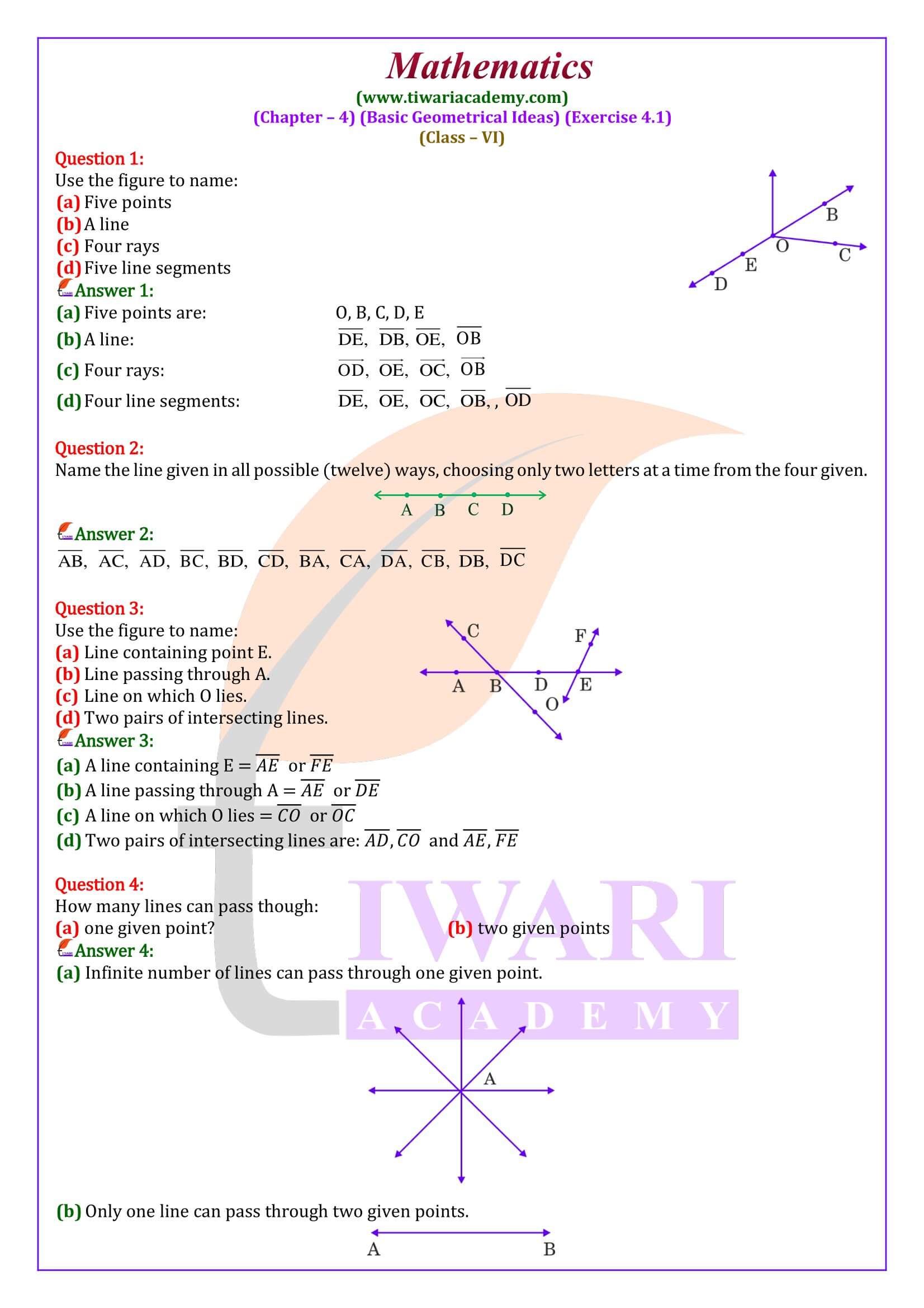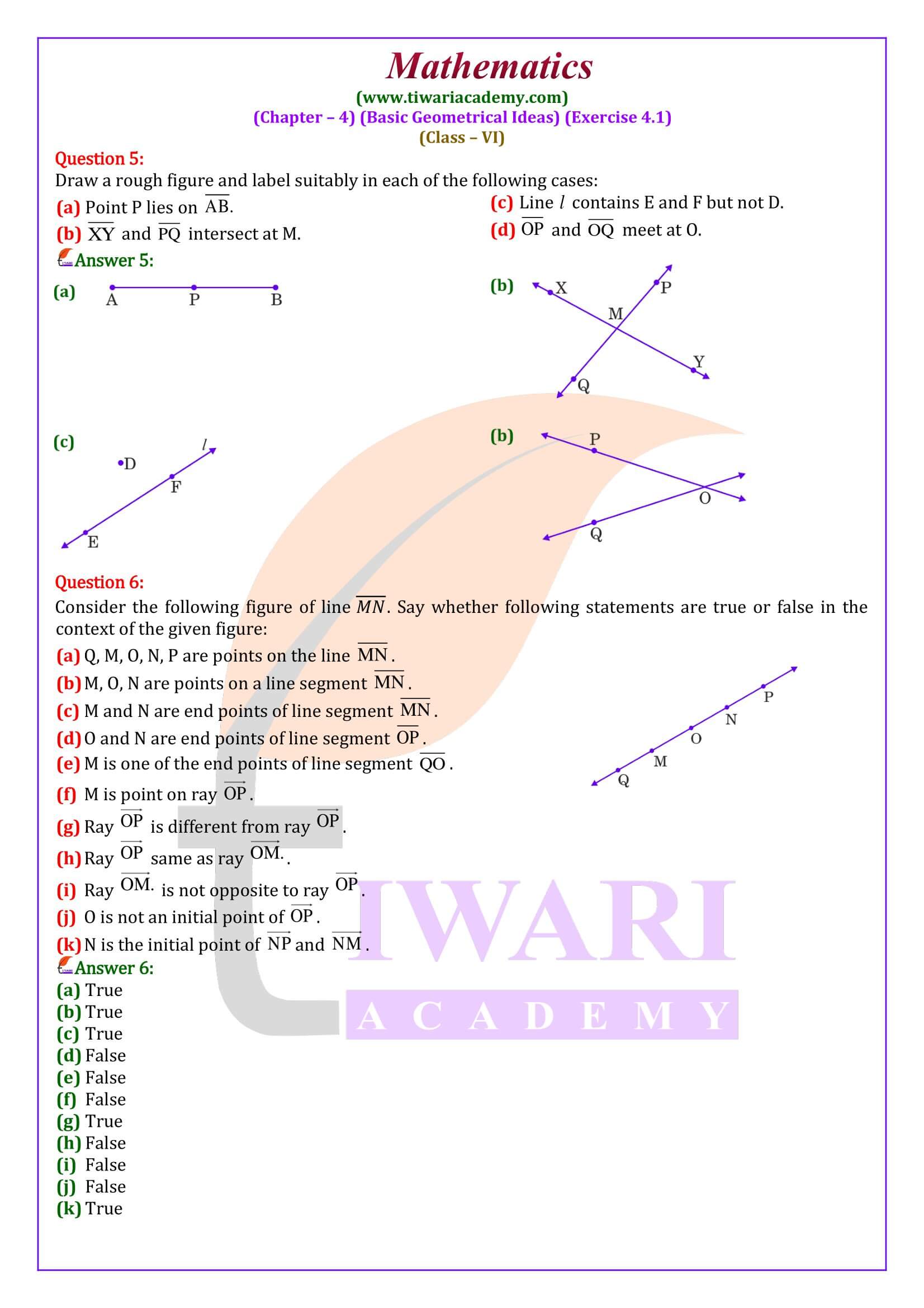NCERT Solutions for Class 6 Maths Chapter 4 Exercise 4.1 in Hindi and English Medium updated for CBSE 2024-25 session. Get here revised solutions of 4.1 class 9th Maths based on rationalised syllabus and new NCERT books for CBSE 2024-25 exams.
6th Maths Exercise 4.1 Solution in Hindi and English Medium
Class 6 Maths Chapter 4 Exercise 4.1 Solution
Class VI Mathematics NCERT Ex. 4.1 of chapter 4 Basic Geometrical Ideas in Hindi and English Medium updated for academic session 2024-25. Videos related to 6th Maths exercise 4.1 is also given below to with solution and explanation separately. These grade 6 NCERT textbook Maths solutions are also useful for state board students.
| Class: 6 | Mathematics |
| Chapter: 4 | Exercise: 4.1 |
| Chapter Name: | Basic Geometrical Ideas |
| Medium: | Hindi and English |
| Content Type: | Text, Images and Videos |
Introduction of Geometry
The term ‘Geometry’ is the English equivalent of the Greek word ‘Geometron’. ‘Geo’ means Earth and ‘metron’ means measurement, i.e., geometry means measurement of the earth. The geometry shaped up when men felt the need to measure their lands while buying and selling. Various shapes and figures with which we deal in geometry are called geometrical figures. In geometry, we learn about the construction of geometrical figures and study their basic properties. Thus, we can say that geometry is the science of properties and relations of figures.
Basic Terms in Geometry
In this chapter 4 of 6th Mathematics, we shall learn about some basic concepts and terms in geometry. There are three basic terms, namely Point, Line and Plane which form the building blocks of geometry. These terms cannot be precisely defined. However, we give some examples to illustrate the meaning of these terms.
POINT
A point is a mark of position. A point depicts the exact position of an object. It does not have any size. It has neither length, nor breadth, nor height. A small dot (.) made by a sharpened end of pencil on a plane sheet of paper, a tiny prick made by a fine pin on a paper, the corners of a rectangle, the tip of an ice-cone etc. are all physical examples of a point.
LINE
The word ‘line’ usually refers to a ‘straight line’.
A line has no width. It has just length. It is absolutely straight and can extend indefinitely in both directions.
Note:
In geometry, by a line we mean the straight line as a whole and not a part of it. Since a line extends indefinitely in both the directions, it cannot be drawn or shown wholly on a sheet of paper.
Class 6 Maths Exercise 4.1 Important Extra Questions
What do you mean by segment of a line?
A line has no width. It has just length. It is absolutely straight and can extend infinitely in both directions. But practically we cannot draw a line which length is infinite, so we use a piece of line or segment of a line.
Who first invented Geometry?
6th century BC in Greek, Euclid was a great mathematician and often called the father of geometry.
What do you mean by plane in geometry?
In geometry, by a plane we mean the whole plane and not just a portion of it. Since a plane extends indefinitely in all the directions, we cannot draw a plane on a sheet of paper. We can show only a part of it on the paper by drawing a rectangle or a parallelogram.
PLANE
Every solid has a surface which may be flat or curved. The surface may be smooth or rough also.
For example, the surface of the blackboard is flat and the surface of a cricket ball is curved. Flat surfaces are known as plane surfaces and other surfaces are known as curved surfaces.
So, a plane is a flat surface which extends indefinitely in all directions
Which topics will be introduced in exercise 4.1 of class 6th Maths?
In exercise 4.1 of class 6th Maths the following topics will be introduced:
- Points
- A Line Segment
- A Line
- Intersecting Lines
- Parallel Lines
- A Ray
What are some real-life examples given in 6th Maths Exercise 4.1?
Some real-life examples of:
1. Line segments are an edge of a box, a tube light, the edge of a postcard, etc.
2. Intersecting lines are two adjacent edges of your notebook, the multiplication sign X , crossing-roads, etc.
3. Parallel lines are the opposite edges of the ruler (scale), the cross-bars of this window, rail lines, etc.
4. Rays are the beam of light from a lighthouse, rays of light from a torch, sun rays, etc.
Which questions of exercise 4.1 of class 6th Maths have a chance to come in the exams?
Exercise 4.1 of class 6th Maths has 6 questions. The questions of exercise 4.1 of class 6th Maths that have a chance to come in the exams are questions 1, 5, 6. From this exercise, short answer-type questions like fill-ups, true or false, MCQ, one-word answers, etc can also come.
Does exercise 4.1 of class 6th Maths take more time as compared to other exercises?
No, exercise 4.1 of class 6th Maths is not at all lengthy. It is a short exercise. This exercise has only 6 questions and no example. Students need at most 1 day to finish exercise 4.1 of class 6th Maths. This exercise is also very easy.






